HOPE-SPOTTING
In numbers: Five spots of Covid-19 hope (Caution: There’s a ‘But’)
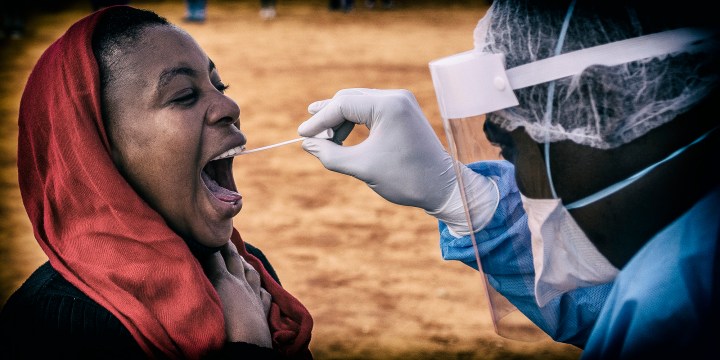
The epidemic has moved from the calm before the storm to the amplification phase, but tests are up and deaths are low.
Hope Spot 1
The hard lockdown has worked. The draconian Level 5 lockdown has kept South Africa’s case numbers at a level that places it among the countries with the lowest caseloads, as this chart shows. It’s from a presentation that Health Minister Zweli Mkhize made to Parliament’s health committee on April 27.

Professor Adrian Puren of the National Institute of Communicable Diseases. (Photo: supplied)
But, Dr Adrian Puren of the National Institute of Communicable Diseases warns that, “We are in the amplification stage of the pandemic that requires control and mitigation. We tried to contain the introduction of the virus by case definitions that focused on travellers and their contacts, but we are seeing sustained human-to-human transmission in communities and significant clusters.”
The clusters are occurring regularly now: from the first cluster in the Free State which saw a spread of infections from a single church gathering, to the Alexandra cluster spread by a single young man, to the St Augustine’s Hospital cluster in Durban which infected at least 71 health workers and saw four people die. Today, Mkhize said there had been a cluster outbreak at the state’s National Health Laboratory at Groote Schuur Hospital.
“The expansion is not exponential but sufficient transmission is occurring,” warns Puren. As South Africa moves from lockdown Level 5 to Level 4, he says it is critical to monitor the rate at which the virus is reproducing so it is kept to a factor of less than one, or South Africa risks exponential growth.
“The curve has flattened rather than exploded to exponential growth. So the reproductive number [of the virus] has certainly decreased but we do not have relevant information that the ‘R Nought’ [scientific term for the rate of replication of the virus] has been fully met,” says Puren. He adds that non-peer-reviewed studies suggest a slow replication which could explain the careful lowering of lockdown levels.
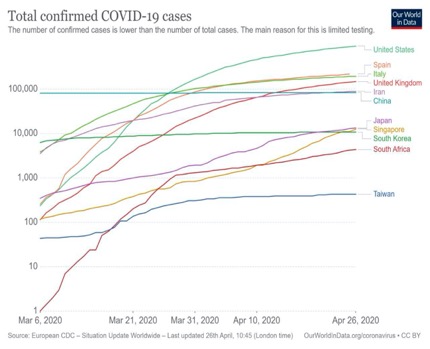
Hope Spot 2
While every death is one too many, South Africans are not dying in the same numbers (even per capita) as in other countries. This may be because we are not yet in the eye of the Covid-19 storm. This chart shows that although the number of deaths (87) in South Africa is higher than Singapore and Taiwan, both city-states, and which have the lowest deaths in the world, South Africa is among the countries with the lowest number of deaths so far.
“My sense is that we have a low case fatality rate [CFR] but we are at an early phase of the epidemic in South Africa,” says Puren.
But, he warns against trying to impute a mortality rate at this point in the epidemic:
“We should be cautious when trying to calculate a CFR during the course of an epidemic. There may be underestimation/overestimation of the actual number of cases or under/over-estimation of the number of deaths.”
The “crude” fatality rate in SA is now 1.9% of cases and those deaths are 0.0001% of the population, says Puren. The Wuhan CFR is calculated at 2% (the other coronavirus fatality rates were Sars at 9.6% and the much more lethal Mers at 34%).
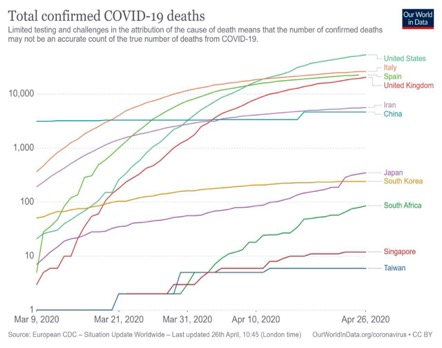
Hope Spot 3
Testing is picking up as the 67 mobile units of the National Health Laboratories Services increase their ability for mass community testing. In a presentation by Mkhize on April 27, you can see that 168,000 tests across the private and public labs have been done. Important to note is that the capability of public labs is improving. Mass testing enables a country to build an accurate infection profile on which to base decisions such as the level of lockdown to be engaged. The current testing level suggests Level 4 is necessary for at least the foreseeable future, but if testing is ramped, then a more accurate picture can tell scientists if the trend picked up in Spot 1 is both accurate and sustained.
Puren says a recent scenario being used in South Africa is that testing needs to be at least equivalent to South Korea (17,322 tests a day; or testing one in 150 people). At best, it must be equivalent to testing in Germany (equating to 36,399 tests per day in South Africa).
“Testing has certainly increased, but the current rate of testing is 1.8 tests per million. There is certainly investment in high throughput systems as well as near point-of-care molecular diagnostics that will affect the turnaround times, which is critical for management and informing where we are in the epidemic.
“Factors that will affect levels of testing are staffing and access to reagents [testing chemicals],” says Puren.
Mkhize said 5.8 million people had been screened by April 23 and 41,000 of those had been referred for testing. The NHLS says test turnaround times are getting faster.
“There have been noteworthy improvements. Currently, the total testing turnaround time in April is under 48 hours, with some areas much lower,” said the national labs in response to a Daily Maverick question.
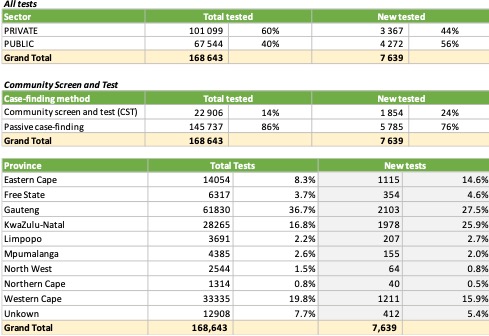
Hope Spot 4
Gauteng has kept deaths down and preparedness is high. This is important because the province is the country’s most densely populated with the highest number of closely packed areas. This can have implications for the exponential growth of infections.
These charts show where the highest number of deaths have occurred: the Western Cape and KwaZulu-Natal. While Gauteng was until recently the infection epicentre, it has now been overtaken by the Western Cape. In both provinces, cities remain the vectors of growth. Gauteng has contained the fatality rate through radical screening and testing as well as quarantine-ready sites.
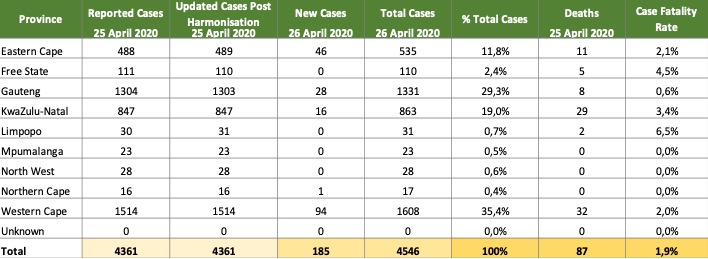
Hope Spot 5
As chief Covid-19 scientist Salim Abdool Karim said in his first national presentation to the country, there is no way that South Africa can avoid the pandemic. But what the hard lockdown did is buy time for the country to prepare its health system. These two tables show that preparation is now well underway. South Africa now has 288 quarantine sites for people who may not be able to self-isolate and it has 23,604 planned beds. This is insufficient for an exponential curve growth, but it is close enough to planning for a well-managed amplification stage.
The infection map shows that in three of the nine provinces, the virus has not travelled (although this may mean that mass testing has not yet revealed the true picture in these provinces). District-level infection rates are slowly becoming more transparent. Deep and detailed viral curve information is vital to plan and prepare hospitals, clinics and other health facilities as well as to prepare quarantine sites and field hospitals (for triage and diversion of cases) as required.
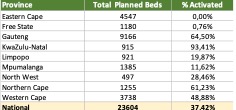
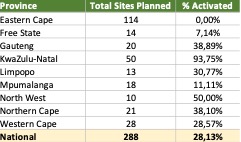
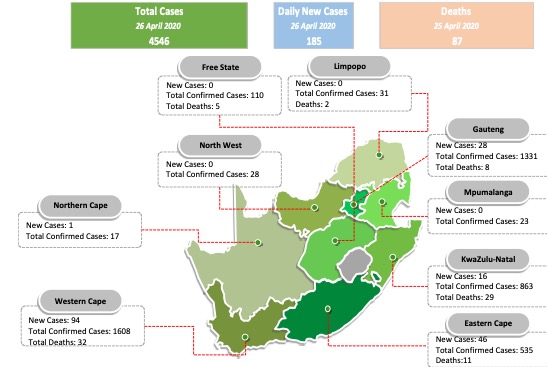
"Information pertaining to Covid-19, vaccines, how to control the spread of the virus and potential treatments is ever-changing. Under the South African Disaster Management Act Regulation 11(5)(c) it is prohibited to publish information through any medium with the intention to deceive people on government measures to address COVID-19. We are therefore disabling the comment section on this article in order to protect both the commenting member and ourselves from potential liability. Should you have additional information that you think we should know, please email [email protected]"



 Become an Insider
Become an Insider